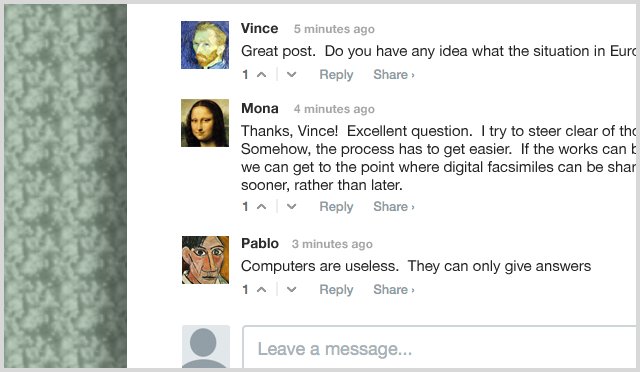Advice on how to start a museum blog

There. See what I did there? Up there in the title of this post? Go over to Google and type in "advice on how to start a museum blog". Or "how to start a museum blog". Or "museum blog". I'll wait.
Assuming a few weeks have gone by since I published this piece, hopefully it should rank pretty high for museum professionals who are looking to start a blog. Fingers crossed. (Editor's note, 9/14/13: This post now ranks #2 for "how to start a museum blog". Your mileage may vary.)
We'll come back to this.
Having a blog is an excellent idea for your museum. There's no easier way to open a spigot of traffic to your site. Done right it can also easily boost your site's search engine visibility for topics you already "own". Finally, it's a great tool for audience development and it can help you connect with new audiences you wouldn't otherwise reach - on the other side of the world.
If you're starting a blog for your museum, here are my thoughts on how to make it great.
Blog on your own site. There are many great blogging platforms out there to help you get started in just a few minutes and with almost no setup, including Blogger/Blogspot, WordPress.com and Tumblr, for starters (Typepad is still kicking, too) and the list goes on and on.
But you should set up your blog on your own site. Otherwise, you negate the two biggest advantages to having a blog - increased traffic and improved/extended search engine rankings for your website - without eliminating any of the work.
It's very easy to set up a blog on your site. If you can't do it yourself, you should hire someone to do it for you. It shouldn't cost much, and you can find dozens of WordPress jockeys in your town to do it for you quickly and for minimal cost. Don't be afraid to pay a few bucks for the setup. It's one of the best investments you can make in your site.
Set up an editorial calendar. With a blog, you are now a publisher, just like any newspaper or magazine. So think like an editor and establish a list of topics to write about along with a schedule for rolling them out. Try to come up with 20-30 stories (I challenge you!) As you post from that list periodically add a few more.
This helps you avoid the situation where you haven't blogged in weeks and are under the gun to come up with something - anything! - to write about, and the "cupboard is bare". It'll improve the quality of your posts because you'll be "posting with a purpose" rather than whatever comes to mind on the spur of the moment.
Doing this should be pretty easy. After all, you're a museum! You have a uniquely interesting collection of art, history and culture!
Think about SEO (search engine optimization). Think about the words and phrases people might use to google you. Think about including some variation of them in the title of your post. Search engines also give weight to subheadings and especially to the URL of your post (hopefully your CMS will allow you to control the URLs), so consider optimizing those elements, along with the copy.
Look again at the title of this post, and the URL. Think about what a museum professional who's thinking about blogging might type in to a search engine to find "advice". Is that how you ended up finding this post?
Don't overthink SEO. Don't concentrate so hard on the SEO of your posts that you make it hard to just write a good post that doesn't seem stilted. Focus first on telling a good story. Write up your post, then make a pass through it to see if you can spruce it up for the search spiders.
Recruit your resident Subject Matter Experts to share the load. Get other staff members in on the action. If you have a curator who likes to write, you are very lucky! Chances are your curators are very busy, so when you present the idea of blogging to them, don't make it seem like another task, tell them it's an opportunity to tell the whole world about the wonderful work they are doing and how interesting it is (and it is interesting, or you wouldn't be doing it).
Write up the occasional list. Everyone is a sucker for lists, and there are lots of good reasons to write them up as blog posts. They are very easy to write, people love to click on a link to them, and it's also a common way people use search engines (i.e. "top 10 museum websites", "10 best blogging platforms"). They are so good at generating in-bound traffic that list articles now represent 30% of all blog posts.
Write them judiciously, however, because "listicles" have - deservedly - a reputation for being among the most vapid posts on the Web. As you probably know, they are widely used as link bait. So if you decide to write up "Top [3, 5, 10, 77] Things You Didn't Know About [Norman Rockwell, Andy Warhol, Harriet Beecher Stowe]" make them count. All [3, 5, 10, 77] of them. Otherwise you haven't engaged a reader, you've annoyed them.
Write for the Web. On the Web, people don't read, they scan. Keep your paragraphs short (like this one), use subheadings, blockquotes and where appropriate, bulleted lists to break things up.
Posts don't have to be long. Writing a blog post isn't like writing a dissertation. In fact, short posts are easier for busy people to digest. So don't write ten paragraphs when five will do. Your readers will thank you for it.
Blog "as often as possible". People often ask me how often they should post to their blog. The answer is "as often as you can". That's going to be different for different people. Several times a week, once a week, once a month, even once a quarter - it's all good. The only other thing I'd say is that you should try to do a lot of writing soon after launching your blog, to get a healthy number of posts up relatively quickly.
Don't worry about whether you are a good writer. Assume that you are. Tell yourself that you are. Blogging is like anything else - you'll get better over time. Just do it.
Consider an editorial policy. You may want to adopt standards for what is appropriate to say on a blog, especially if several staff members will be contributing to it. If you have any other comprehensive policy for employee conduct, that may work fine for you, but you may want to take things a step further and define what kind of colorful language or imagery is out of bounds or lay out editorial responsibilities. Consult your HR staff and attorney.
Think about how you want to moderate comments. I recommend that you allow people to comment on posts. It's a great way to create engagement, answer questions and spur an interesting discussion. But you may want to create standards for what is appropriate and make sure your readers can access it. You wouldn't allow foul language or arguments to erupt in your gallery; don't tolerate it on your blog. Just make sure you're consistent about it.
Use Disqus for commenting. It's drop-dead simple to implement, does an excellent job preventing spam commenting, creates easy-to-follow discussion threads and is very easy for you to use to moderate your comments as you see fit.
Don't get discouraged if nobody comments. It doesn't mean people aren't reading, and a post that isn't very popular today might just generate a ton of traffic two years from now because someone suddenly decided to link over to it.
Blogging requires discipline. It always amazes me how often social media specialists say blogging is easy and imply it's effortless. Blogging for your museum should be easy, because I'm sure you have a lot to say, but unless you really love to write, it's going to take some effort. It doesn't have to take a whole lot of your time, but don't forget that it will take some time. A (well-written) blog post takes time to craft. The first couple articles, especially, may take a while to generate.
It's well worth the effort, though, so push through. At some point, you'll realize you have a few dozen posts about interesting things that people can find no where else on the Internet (or even in your building), because your museum is special, of course. So get to work telling the world your story!

